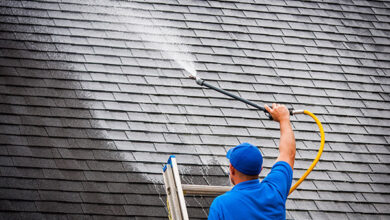The Complete Guide to Gutter Installation: Protecting Your Home from the Top Down

When it comes to safeguarding your home from water damage, gutters are one of the most essential yet underrated components. While they might seem like a minor detail in the grand scheme of home construction or renovation, a properly installed gutter system is your home’s first line of defense against erosion, foundation damage, and structural deterioration.
Understanding the Gutter Installation process—what it involves, why it matters, and how to get it done right—is crucial for every homeowner. This in-depth guide walks you through everything you need to know, from types of gutters and materials to signs it’s time to replace your system and how to choose the right contractor.
Why Gutters Matter More Than You Think
Gutters serve a very specific yet vital purpose: directing rainwater away from your home. Without them, water runs off the roof unchecked, soaking into the ground around your foundation, splashing against walls and siding, and causing long-term structural issues. Here’s how gutters protect your property:
- Prevent foundation damage by redirecting water away from the base of your home.
- Stop soil erosion around landscaping, flower beds, and patios.
- Reduce basement flooding by keeping moisture from collecting near basement walls.
- Protect siding and paint from water staining and mold growth.
- Preserve roofing and fascia by controlling water runoff from the roof.
Poor or absent gutters don’t just lead to an occasional puddle—they can cost thousands in repairs if neglected over time.
Signs You Need a New Gutter System
Before exploring the ins and outs of Gutter Installation, it’s important to recognize when your current system is failing. Here are the common warning signs that replacement is overdue:
- Cracks or holes in the gutter troughs
- Sagging or separating gutters that pull away from the roofline
- Rust or corrosion, especially around joints and seams
- Peeling exterior paint near gutters, a sign of overflowing water
- Water pooling near the foundation after rainstorms
- Basement leaks or dampness, often from poor water redirection
- Rotting fascia boards or mildew under the roof overhang
A proactive approach to replacing or upgrading your gutters can prevent more costly structural repairs later.
Choosing the Right Gutter Type
Modern gutter systems come in several styles, materials, and configurations. Your choice depends on factors like home size, roof pitch, local weather conditions, and aesthetic preferences.
1. Gutter Styles
The two most common profiles are:
- K-style Gutters: Shaped like crown molding, these are popular for their capacity and stylish look. Suitable for most residential homes.
- Half-round Gutters: A more traditional, rounded shape. Often found on historic or high-end homes.
Less common but still used in specific applications are box gutters, fascia gutters, and custom seamless profiles.
2. Gutter Materials
Each material offers unique benefits in terms of durability, cost, and appearance:
| Material | Pros | Cons |
| Aluminum | Lightweight, rust-proof, low-cost | Can dent easily |
| Vinyl | Inexpensive, easy to install | Becomes brittle in cold climates |
| Copper | Durable, beautiful, long-lasting | Expensive, requires professional install |
| Steel | Strong, resistant to impact | Can rust without protective coating |
| Zinc | Extremely long-lasting | Costly and requires expert installation |
Aluminum remains the most popular choice due to its combination of affordability and performance.
Gutter Size and Capacity
Gutter sizes typically range from 4 inches to 7 inches, with 5-inch and 6-inch being most common for residential homes. Choosing the right size depends on:
- Roof area and pitch: Steeper roofs collect more rain faster.
- Local rainfall intensity: Homes in heavy-rainfall areas may need wider gutters.
- Downspout placement and spacing: These affect water flow efficiency.
A contractor can calculate the correct gutter size based on roof measurements and drainage requirements.
Downspouts: The Unsung Heroes
No gutter system is complete without downspouts, which direct water from the gutters to the ground or a drainage system. Key considerations include:
- Quantity: Most systems require one downspout every 30–40 feet.
- Placement: Ideally at corners or low points of the gutter system.
- Extensions: Can lead water several feet away from the foundation.
Proper downspout sizing and positioning are just as important as the gutters themselves when it comes to overall performance.
The Gutter Installation Process: What to Expect
If you’re hiring a professional or even attempting a DIY project, here’s a general outline of what the Gutter Installation process involves:
1. Assessment and Planning
- The roof is measured, and water flow is analyzed.
- Style, material, and color are selected to match the home’s exterior.
- Placement of gutters and downspouts is determined for optimal performance.
2. Removal of Old Gutters (if applicable)
- Existing gutters and downspouts are carefully taken down.
- Any damaged fascia or soffit boards are repaired before new installation.
3. Installation of Hangers or Brackets
- Gutter hangers are mounted to the fascia board at proper intervals (usually every 2–3 feet) to support the new gutters.
4. Cutting and Fitting Gutters
- Sections are cut to fit the home’s dimensions.
- For seamless systems, gutters are rolled out on-site to exact lengths.
5. Mounting and Sealing
- Gutters are attached to the hangers.
- Joints and seams are sealed with high-quality waterproof sealant (if not seamless).
- Downspouts are connected and secured with brackets.
6. Final Testing
- Water is run through the system to check for leaks, blockages, or improper slopes.
- Adjustments are made to ensure proper drainage away from the home.
Seamless vs. Sectional Gutters
One of the biggest decisions homeowners face is whether to install seamless or sectional gutters.
Seamless Gutters
- Made from a single continuous piece of metal, custom-cut on-site.
- Fewer joints mean less chance of leaks.
- Cleaner appearance and lower maintenance.
- Requires professional installation.
Sectional Gutters
- Assembled from pre-cut lengths.
- Easier and cheaper to install, especially for DIYers.
- Higher risk of leaks at seams.
- More maintenance is required over time.
While seamless gutters come at a higher upfront cost, they generally offer better long-term performance.
Gutter Guards: Are They Worth It?
Gutter guards are mesh, foam, or screen covers that sit on top of your gutters to prevent debris like leaves and twigs from entering. They can:
- Reduce how often you need to clean your gutters.
- Help prevent blockages and overflows.
- Minimize pest nesting inside gutters.
However, they’re not maintenance-free. Debris can still sit on top of the guards and need to be brushed away. If you live in a heavily wooded area or want low-maintenance upkeep, they can be a wise investment.
Maintenance Tips for Long-Lasting Gutters
To get the most from your newly installed gutters:
- Clean gutters at least twice a year (spring and fall).
- Inspect for sagging, leaks, or damage after heavy storms.
- Check downspout flow—if water isn’t exiting properly, flush with a hose.
- Trim nearby tree branches to reduce leaf buildup.
- Tighten hangers or brackets if gutters pull away from the house.
Proper care extends the life of your gutter system and maintains its effectiveness for years to come.
Cost of Gutter Installation
The cost of Gutter Installation varies widely depending on material, house size, accessibility, and design complexity.
Average Price Ranges (Per Linear Foot):
- Vinyl: $3 – $6
- Aluminum: $5 – $10
- Steel: $9 – $20
- Copper: $20 – $40
For a standard single-story home with 150–200 linear feet of guttering, the total cost may range from $1,000 to $2,500, depending on upgrades like seamless installation or gutter guards.
Always request a detailed quote that includes materials, labor, disposal, and optional extras.
Choosing the Right Installer
Your gutter system is only as good as the quality of its installation. When selecting a contractor:
- Look for licensed and insured professionals.
- Check online reviews and ask for local references.
- Ask about warranty coverage on materials and labor.
- Get multiple estimates and compare not just prices, but services included.
A trustworthy installer will offer consultation, answer all your questions, and provide transparency in pricing and timelines.
Final Thoughts
Gutters might not be the flashiest feature of your home, but they play a crucial role in protecting it. A properly designed and installed system doesn’t just manage rainwater—it preserves the integrity of your roof, walls, foundation, and landscaping. With so many material and style options, every homeowner can find a gutter solution that fits their needs and budget.
If you’re considering a new gutter Installation or upgrading your current system, taking the time to understand your options and work with experienced professionals will pay off in long-term peace of mind and home protection.




